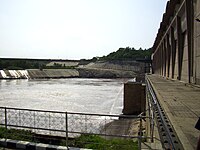Mangla Dam: Difference between revisions
→Historic development: per source |
|||
| Line 24: | Line 24: | ||
}}</ref> |
}}</ref> |
||
The Mangla Dam was the first development project undertaken to reduce this shortcoming and strengthen the irrigation system. The dam was damaged |
The Mangla Dam was the first development project undertaken to reduce this shortcoming and strengthen the irrigation system. The dam was damaged due to an [[Indian Air Force]] raid during the [[Indo-Pakistani War of 1971]]. As a consequence, the hydro project was temporarily out of service.<ref>{{cite web |
||
|url=http://www.globalsecurity.org/military/world/europe/hunter.htm |
|url=http://www.globalsecurity.org/military/world/europe/hunter.htm |
||
|title=Hunter |
|title=Hunter |
||
Revision as of 13:00, 13 April 2009
The Mangla Dam (Urdu: منگلا بند) inMirpur Azad Kashmir, Pakistan is the twelfth largest dam in the world [1]. It was built in 1967 with funding from the World Bank.

Historic development
As part of the Indus Waters Treaty signed in 1960, India gained rights to the waters of the Ravi, Sutlej and Beas rivers, while Pakistan, in addition to waters of the above three rivers within Pakistan and some monetary compensation, received the rights to develop the Jhelum, Chenab and Indus river basins through construction of the Indus Basin Project. Until 1967, the entire irrigation system of Pakistan was fully dependent on unregulated flows of the Indus and its major tributaries. The agricultural yield was very low for a number of reasons, the most important being a lack of water during critical growing periods. This problem stemmed from the seasonal variations in the river flow due to monsoons and the absence of storage reservoirs to conserve the vast amounts of surplus water during those periods of high river discharge. [2][3]
The Mangla Dam was the first development project undertaken to reduce this shortcoming and strengthen the irrigation system. The dam was damaged due to an Indian Air Force raid during the Indo-Pakistani War of 1971. As a consequence, the hydro project was temporarily out of service.[4]
The Mangla Dam project
The Mangla Dam is the twelfth largest dam in the world. It was constructed in 1967 across the Jhelum River, about 100 miles (160 km) south-east of the Pakistani capital, Islamabad in Mirpur district of Azad Kashmir, Pakistan. The main structures of the dam include 4 embankment dams, 2 spillways, 5 power-cum-irrigation tunnels and a 1,000 MW power station.

The main dam is 10,300 feet (3140 m) long and 454 feet (138 m) high (above core trench) with a reservoir of 97.7 square miles (253 km²). Since its first impounding in 1967, sedimentation has occurred to the extent of 1.13 million acre feet (1.39 km³), and the present gross storage capacity has declined to 4.75 million acre feet (5.86 km³) from the actual design of 5.88 million acre feet (7.25 km³). The live capacity has declined to 4.58 million acre feet (5.65 km³) from 5.34 million acre feet (6.59 km³). This implies a reduction of 19.22% in the capacity of the dam.
The power station of mangla dam consists of 10 units each having capacity of 100 MW.
In order to remedy the storage capacity decreases, the Pakistani government has decided to raise the dam by 40 feet (12 m), to 494 feet (151 m) high. This will increase the reservoir capacity by 18% and provide an additional 644 MWh of power, but will displace 40,000 people currently living near the reservoir.
The project was designed primarily to increase the amount of water that could be used for irrigation from the flow of the Jhelum and its tributaries. Its secondary function was to generate electrical power from the irrigation releases at the artificial head of the reservoir. The project was not designed as a flood control structure, although some benefit in this respect also arises from its use for irrigation and water supply. The Government of Pakistan had agreed to pay royalties to the Government of AJK(Azad Jamu and Kashmir) for the use of the water and electricity generated by the dam. Over 280 villages and the towns of Mirpur and Dadyal were submerged and over 110,000 people were displaced from the area as a result of the dam being built. Some of those affected by the dam were given work permits for Britain by the Government of Pakistan, and as a result, in many cities in the UK the majority of the 'Pakistani' community actually originated from the Mirpur area of Disputed region Jamuu Kashmir.
Mangla Dam is approx 100 miles (160 km) south-east of the Pakistani capital, Islamabad while Tarbela Dam is 60 miles (100 km) northwest.
Mangla View Resort
Mangla view resort is the first planned resort development in Pakistan to offer residences, villas, townhouses, hotels, serviced apartments & retail outlets. The resort is located on a 340-acre (1.4 km2) site on the Mangla Dam area.
Clubs & Facilities:
- Golf Club
- Family Club
- Water Sports Club
- Riding Club & Extreme Water Park
References
- ^ Pakistan Water Gateway
- ^ "Tarabela Dam". www.structurae.de. Retrieved 2007-07-09.
- ^ "Indus Basin Project". Encyclopedia Britannica. Retrieved 2007-07-09.
- ^ "Hunter". Global Security.org. Retrieved 2007-07-09.
